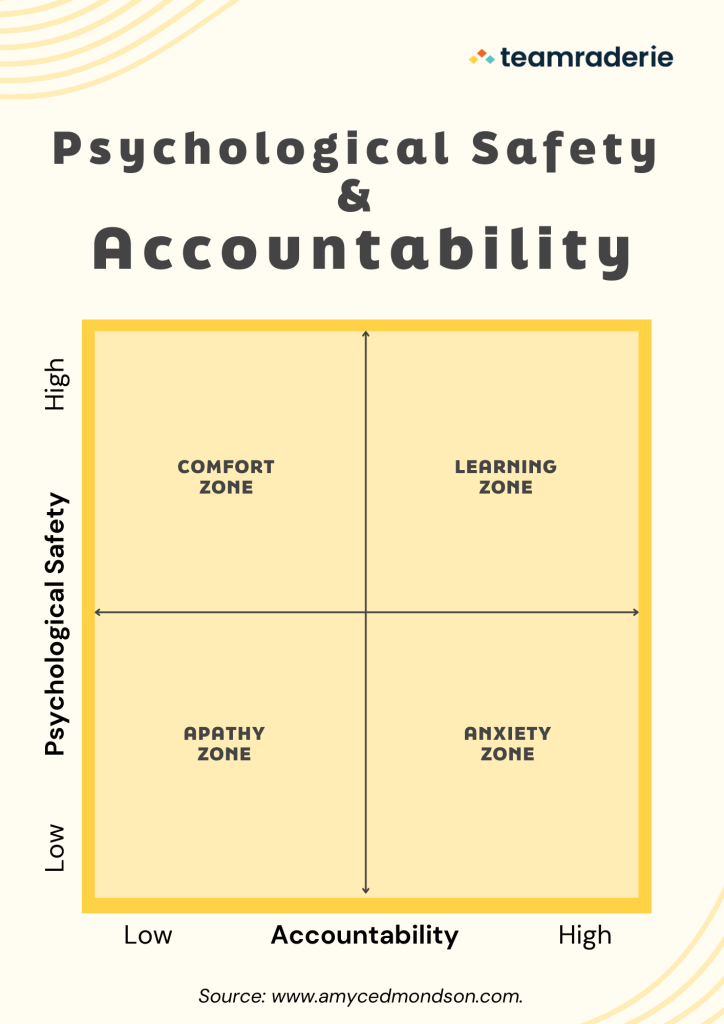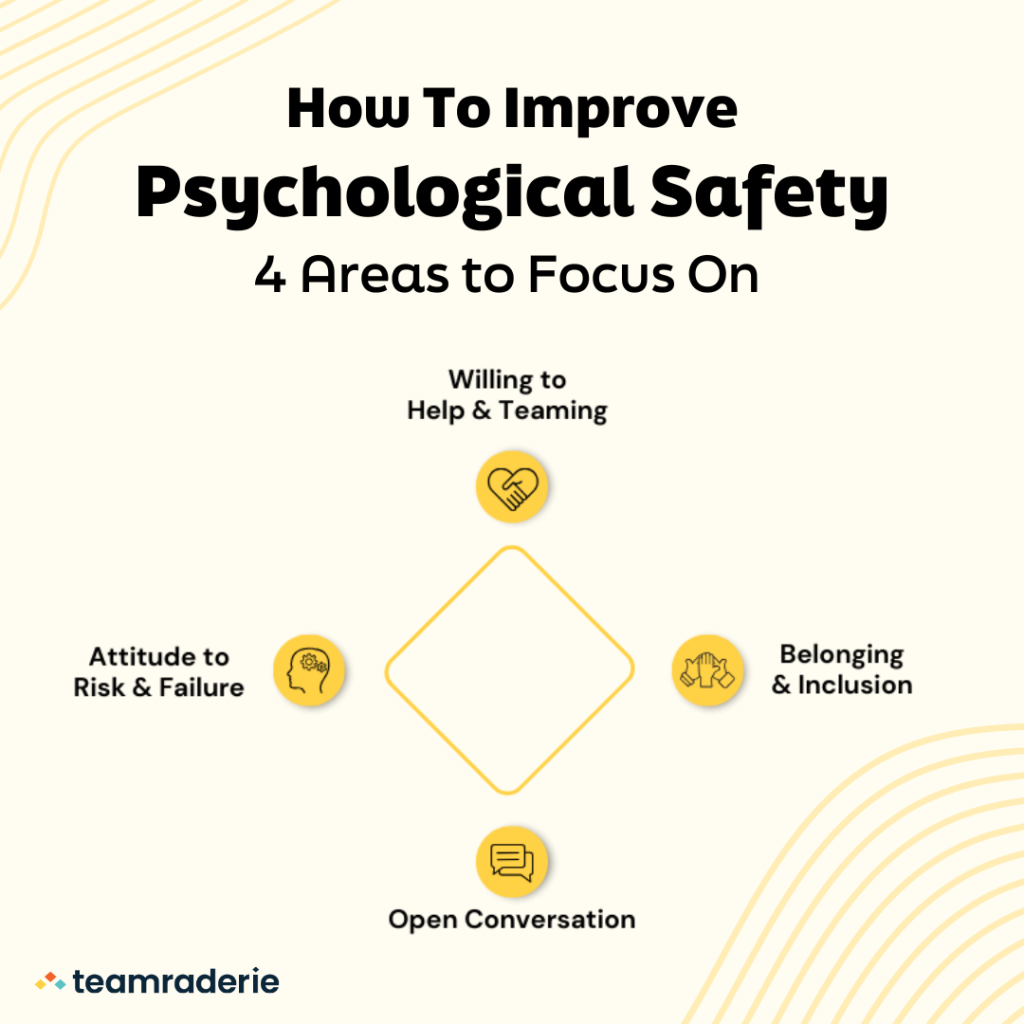There are many situations at work in which bad news needs to be delivered. Whether it’s a failed project, an unforeseen obstacle, or a missed benchmark, it’s always uncomfortable to deliver bad news to a boss.
Employees may be tempted to withhold information to frame it in a more positive light. For example, if there’s an issue with a product that would delay its release date, employees might decide to conceal the issue to avoid any tension.
It’s not difficult to understand why this might be the case—withholding this type of information can feel safer than facing the consequences of being the one who holds up a project.
However, particularly when it comes to consumer safety, this can have severe repercussions for the organization and consumers as well.
To prevent this type of situation from occurring, leaders need to create psychologically safe cultures.
But what does this entail, why is it important, and how can you create psychological safety in your organization?
What Is Psychological Safety?
Psychological safety is about creating a workplace where employees don’t feel compelled to keep silent, regardless of any external or internal pressures they may face.
“Psychological safety describes a work environment where people believe that speaking up is feasible,” says Harvard Business School Professor Amy Edmondson in the Leadership Lab event, Creating a Fearless Organization. “Not easy, necessarily, but expected, desired, welcomed.”
In a psychologically safe environment, employees feel that they can safely:
- Disagree with the boss
- Ask a question
- Express a concern
- Admit a mistake
- Take risks
As Amy Edmondson puts it, it’s the absence of interpersonal fear.
Common Misconceptions About Psychological Safety
There are several common misconceptions about what psychological safety entails. Some of the most common include:
- It’s about being nice: Psychological safety isn’t about simply being “nice” to everyone. In an attempt to “treat people nicely,” important discussions are often avoided. Psychological safety is about feeling comfortable having those important discussions without risk of punishment.
- It conflicts with accountability: Psychological safety isn’t about creating a permissive culture. It’s about employees feeling safe taking risks and speaking up, but not crossing boundaries and breaking rules. Psychological safety can operate within the parameters of what’s acceptable in the workplace.
- It’s just about feeling comfortable: Psychological safety isn’t about being comfortable, but rather about candidly expressing observations without fear of negative consequences such as humiliation or punishment.
Ultimately, psychological safety is about comfort with candor. This can result in uncomfortable situations, but ensuring employees feel safe in the long term is important.
Can You Have Too Much Psychological Safety?
Leaders often worry about creating “too much psychological safety.” In these situations, however, it’s not the amount of psychological safety that’s the issue, but rather the absence of other important factors like accountability.
Don’t worry about crossing an invisible “psychological safety threshold” thus creating a culture of “comfort” and permissibility at the expense of performance. Instead, consider pairing psychological safety with accountability and performance standards.
When employees know the limitations and boundaries they aren’t allowed to cross, they feel safer taking risks within those constraints.
According to Edmondson’s research, problems arise when psychological safety and performance standards are out of balance:
- Apathy zone: Low psychological safety, low accountability. Workers tend to be disengaged and reluctant to speak up, resulting in stagnation and low innovation.
- Comfort zone: High psychological safety, low accountability. Workers feel comfortable speaking up and taking risks, but there’s a low sense of ownership over outcomes.
- Anxiety zone: High accountability, low psychological safety. Employees feel uncomfortable speaking up because they feel they’ll be punished for doing so.
- Learning/High-performance zone: High accountability and high psychological safety. Employees feel safe speaking up and taking risks while taking ownership of their actions

The learning zone, where psychological safety and accountability are both high, is what leaders should strive for.
Why Is Psychological Safety Important?
According to research from McKinsey, 89% of business leaders believe it’s important to create a psychologically safe workplace.
Despite this, only 26% of leaders actually create psychological safety in their organizations. This disparity needs to be addressed since it impacts several key factors to organizational success.
According to the World Economic Forum, when a team is psychologically safe, employees are more likely to:
- Learn: Feel comfortable asking questions, admitting mistakes, requesting help, and providing or receiving feedback.
- Contribute: Speak up with ideas or suggestions, contributing to a culture of innovation.
- Challenge: Raise concerns, engage in productive conflict, challenge others, or offer a different perspective.
- Feel included: Feel a stronger sense of belonging, and that they’re involved, valued, and connected with their coworkers.
This, in turn, benefits retention. Research from the Boston Consulting Group found that psychological safety reduces employees’ risk of quitting from 12% to 3%.
Ultimately, psychological safety prevents conformity. Employees feel safe candidly expressing differing opinions, disagreements, and concerns without fear of repercussions. This results in increased innovation and fewer catastrophic and preventable failures. It also benefits employees’ sense of well-being.
“Nearly everybody is engaged in work that requires judgment, creativity, and decision-making, and working with others in an open and sometimes vulnerable way,” says Amy Edmondson in Creating a Fearless Organization. “In order to do a good job in workplaces today, we need to be willing to take interpersonal risks. I need to ask for help if I’m in over my head; I need to admit when I’ve done something wrong; I need to question your judgment.”
How To Improve Psychological Safety On Your Team
According to an article written by Amy Edmondson, there are three steps leaders and team members alike can take to cultivate psychological safety in the workplace.
- Frame challenges as learning opportunities: Give team members or employees permission to experiment or make small mistakes, providing opportunities to learn.
- Invite participation: Ensure that everyone feels comfortable speaking up. Invite participation from those who aren’t as active, and don’t humiliate them for their ideas but give everyone equal respect and consideration.
- Respond appropriately: When you receive bad news or negative feedback, express sincere, enthusiastic, and public appreciation, even if you don’t like what you’ve heard. Then act constructively on that feedback.
While everyone has a role in creating a psychologically safe environment, research has shown that managers have the most significant impact on feelings of belonging at work above co-workers, friends, and senior leaders.
Managers should focus on improving four key areas in a business to create a psychologically safe environment.

1. Foster Belonging and Inclusion
The first step to creating a psychologically safe organization is creating one where employees feel that their voices matter.
According to Gallup, an inclusive organization has three requirements:
- Everyone feels respected
- Employees feel appreciated by management
- Leadership acts in an ethical and moral manner
Research shows that team members often hesitate to voice opinions that differ from commonly shared beliefs. This can prevent them from feeling included.
An excellent way to foster an environment of inclusion and belonging is to intentionally welcome diverse opinions.
Instead of differences being a source of frustration and division, explicitly framing them as a source of value can encourage more people to speak up and contribute their unique thoughts and ideas.
2. Cultivate a Willingness to Help
A key component of speaking up is admitting when you need help. If there’s a culture of unwillingness to help, however, those who do need help will be discouraged from requesting it.
Unfortunately, even when team members offer help, their colleagues might not accept it, regardless of whether it’s needed.
Research from Harvard Business Review (HBR) revealed that employees typically refuse help for the following reasons:
- They feel it might make them look bad or incapable of completing a task
- They don’t want to feel like they owe their coworkers any favors
- They believe their coworkers are offering help just to benefit themselves
- They don’t feel confident in their coworkers’ abilities
To combat these barriers, leaders need to lead by example. HBR advises that leaders demonstrate faith in their employees by:
- Recognizing successful collaborations
- Demonstrate a willingness to help—and be helped
- Avoid rewarding successes from individual employees more than collaborative efforts
These steps can begin to increase team trust and boost the chances of employees giving and receiving help.
3. Foster Open Communication
Approximately 30% of employees are frustrated with unclear communication from their boss. Unfortunately, when news is bad, the instinct is often to hide it.
Candor is one of the most critical components of psychological safety. Employees and managers alike need to feel comfortable addressing problems, raising concerns, asking questions, and discussing ideas.
Open communication is critical for this to occur.
Research from HBR and Amy Edmondson shows that employees aren’t as likely to be willing to share issues or information if they don’t perceive the communication channel as safe. For example, if they don’t know that the information they provide will remain confidential, they aren’t as likely to share it.
Giving employees a wide range of communication and feedback channels and ensuring they know all their options is important because employees’ perception of different channels varies. This is dependent on factors such as
- Relationships with managers and leaders
- Confidence in HR and how supportive they perceive the department
- Perception of the effectiveness and responsiveness of anonymous formal channels
Providing options for sharing feedback increases the chances that they will do so, increasing their feelings of psychological safety and job satisfaction.
4. Approach Risk-Taking as a Learning Opportunity
Taking risks is an important part of psychological safety.
Especially in an organizational context, these risks are often interpersonal. Admitting a mistake or disagreeing with a superior often feels like a significant risk.
It’s vital to keep in mind that risk-taking often entails mistakes. Learning from mistakes is vital, and part of what constitutes intelligent failure.
“We will all make mistakes, like it or not,” says Amy Edmondson in Creating a Fearless Organization. “You want people to be aware of the fact that they’re making mistakes, and then of course you want them to be incredibly forthcoming about it so that mistakes can be caught and corrected before something really bad happens.”
Although risk-taking is important, it’s important to remember that psychological safety doesn’t mean freedom to do whatever someone wants. Employees need to remain within the constraints their role provides.
For example, increasing psychological safety in a hospital doesn’t give doctors free rein to ignore HIPAA and take risks with patients’ lives.
Psychological safety is the ability to do your job to the best of your ability without fear of punishment and take appropriate risks. It doesn’t give you the freedom to do your job incorrectly.
Improving Psychological Safety With Teamraderie
If you’re hoping to improve psychological safety on your team, focusing on strengthening each of the above factors that contribute to a psychologically safe workplace is vital.
Employees need to feel a strong sense of belonging and inclusion, and they need to feel comfortable giving and receiving help, speaking up, and taking interpersonal risks.
Our Psychological Safety Team Journey, co-created with Amy Edmondson, is intended to strengthen each component of psychological safety. Consisting of four team experiences, the Journey will help:
- Create a psychologically safe culture without sacrificing accountability or performance standards
- Improve the authenticity of your team’s leadership capabilities
- Increase your team’s comfort with risk-taking
- Improve each employee’s sense of belonging and inclusion
Click here to learn more about how this Team Journey can help facilitate a psychologically safe culture at your organization.




